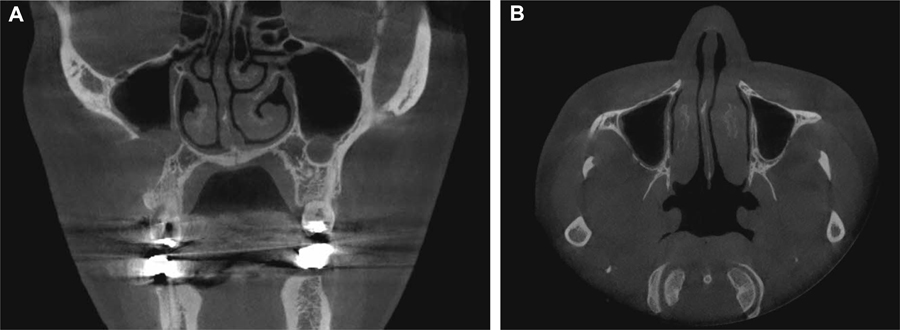J Dent Anesth Pain Med.
2019 Dec;19(6):389-392. 10.17245/jdapm.2019.19.6.389.
Inferior turbinate outfracture for successful nasotracheal intubation in a patient undergoing maxillofacial surgery: case report
- Affiliations
-
- 1Department of Anesthesiology and Pain Medicine, Dankook University Hospital, Cheonan, Korea. mmauss73@gmail.com, mmauss73@dankook.ac.kr
- KMID: 2466654
- DOI: http://doi.org/10.17245/jdapm.2019.19.6.389
Abstract
- An enlarged inferior turbinate is a predisposing factor for difficult nasotracheal intubation. We describe a case of successful nasotracheal intubation by induced outfracture of the inferior turbinate during maxillofacial surgery, and discuss the importance of adequate airway evaluation and anesthetic management for successful nasal intubation.
Keyword
Figure
Reference
-
1. Hall CE, Shutt LE. Nasotracheal intubation for head and neck surgery. Anaesthesia. 2003; 58:249–256.
Article2. Orhan I, Aydin S, Ormeci T, Yilmaz F. A radiological analysis of inferior turbinate in patients with deviated nasal septum by using computed tomography. Am J Rhinol Allergy. 2014; 28:e68–e72.
Article3. Lim CW, Min SW, Kim CS, Chang JE, Park JE, Hwang JY. The use of a nasogastric tube to facilitate nasotracheal intubation: a randomised controlled trial. Anaesthesia. 2014; 69:591–597.
Article4. Kwon MA, Song J, Kim S, Ji SM, Bae J. Inspection of the nasopharynx prior to fiberoptic-guided nasotracheal intubation reduces the risk epistaxis. J Clin Anesth. 2016; 32:7–11.
Article5. Seo KS, Kim JH, Yang SM, Kim HJ, Bahk JH, Yum KW. A new technique to reduce epistaxis and enhance navigability during nasotracheal intubation. Anesth Analg. 2007; 105:1420–1424.
Article6. Lee DC, Jin SG, Kim BY, Yoo S, Han S, Lee YJ, et al. Does the effect of inferior turbinate outfracture persist? Plast Reconstr Surg. 2017; 139:386e–391e.
Article7. Ahmed-Nusrath A, Tong JL, Smith JE. Pathways through the nose for nasal intubation: a comparison of three endotracheal tubes. Br J Anaesth. 2008; 100:269–274.
Article8. Berger G, Hammel I, Berger R, Avraham S, Ophir D. Histopathology of the inferior turbinate with compensatory hypertrophy in patients with deviated nasal septum. Laryngoscope. 2000; 110:2100–2105.
Article9. Min HJ, Min SK, Hong YH, Kim KS. The potential significance of concha bullosa during nasotracheal intubation. J Craniofac Surg. 2016; 27:e153–e154.
Article10. Tong JL, Tung A. A randomized trial comparing the effect of fiberoptic selection and guidance versus random selection, blind Insertion, and direct laryngo scopy, on the incidence and severity of epistaxis after nasotracheal intubation. Anesth Analg. 2018; 127:485–489.
Article11. Cavusoglu T, Yazici I, Demirtas Y, Gunaydin B, Yavuzer R. A rare complication of nasotracheal intubation: accidental middle turbinectomy. J Craniofac Surg. 2009; 20:566–568.12. Prasanna D, Bhat S. Nasotracheal intubation: An overview. J Maxillofac Oral Surg. 2014; 13:366–372.
Article13. Buyuklu F, Cakmak O, Hizal E, Donmez FY. Outfracture of the inferior turbinate: A computed tomography study. Plast Reconstr Surg. 2009; 123:1704–1779.
Article
- Full Text Links
- Actions
-
Cited
- CITED
-
- Close
- Share
- Similar articles
-
- Anatomical Factors Affecting Outcome of Outfracture of the Inferior Turbinate: Radiologic Analysis
- Accidental middle turbinectomy by nasotracheal intubation: A case report
- Retropharyngeal Dissection during Nasotracheal Intubation: A Case Report
- Delayed Detection of Middle Turbinate Fracture after Nasotracheal Intubation: Any Tips for Prevention?
- A Prospective Study on Complications after Nasotracheal Intubation in Oral and Maxillofacial Surgery Patients


